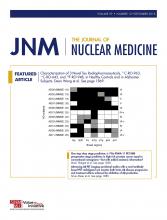Abstract
The goal of this study was to determine the level of clinically acceptable 18F-FDG dose reduction in time-of-flight PET/MRI in patients with breast cancer. Methods: Twenty-six consecutive women with histologically proven breast cancer were analyzed (median age, 51 y; range, 34–83 y). Simulated dose-reduced PET images were generated by unlisting the list-mode data on PET/MRI. The acquired 20-min PET frame was reconstructed in 5 ways: a reconstruction of the first 2 min with 3 iterations and 28 subsets for reference, and reconstructions simulating 100%, 20%, 10%, and 5% of the original dose. General image quality and artifacts, image sharpness, image noise, and lesion detectability were analyzed using a 4-point scale. Qualitative parameters were compared using the nonparametric Friedman test for multiple samples and the Wilcoxon signed-rank test for paired samples. Different groups of independent samples were compared using the Mann–Whitney U test. Results: Overall, 355 lesions (71 lesions with 5 different reconstructions each) were evaluated. The 20-min reconstruction with 100% injected dose showed the best results in all categories. For general image quality and artifacts, image sharpness, and noise, the reconstructions with a simulated dose of 20% and 10% were significantly better than the 2-min reconstructions (P ≤ 0.001). Furthermore, 20%, 10%, and 5% reconstructions did not yield results different from those of the 2-min reconstruction for detectability of the primary lesion. For 10% of the injected dose, a calculated mean dose of 22.6 ± 5.5 MBq (range, 17.9–36.9 MBq) would have been applied, resulting in an estimated whole-body radiation burden of 0.5 ± 0.1 mSv (range, 0.4–0.7 mSv). Conclusion: Ten percent of the standard dose of 18F-FDG (reduction of ≤90%) results in clinically acceptable PET image quality in time-of-flight PET/MRI. The calculated radiation exposure would be comparable to the effective dose of a single digital mammogram. A reduction of radiation burden to this level might justify partial-body examinations with PET/MRI for dedicated indications.
Footnotes
Published online Jun. 7, 2018.
- © 2018 by the Society of Nuclear Medicine and Molecular Imaging.







